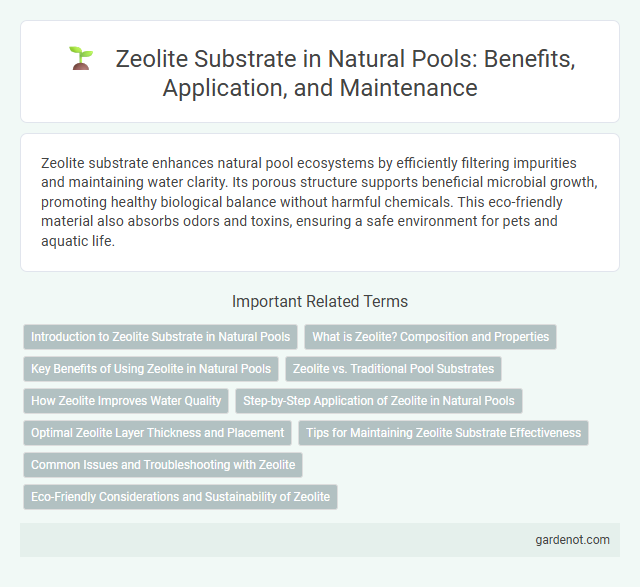Zeolite substrate enhances natural pool ecosystems by efficiently filtering impurities and maintaining water clarity. Its porous structure supports beneficial microbial growth, promoting healthy biological balance without harmful chemicals. This eco-friendly material also absorbs odors and toxins, ensuring a safe environment for pets and aquatic life.
Introduction to Zeolite Substrate in Natural Pools
Zeolite substrate in natural pools acts as a highly effective biofilter, utilizing its microporous structure to trap impurities and support beneficial bacterial colonies. This mineral enhances water clarity and reduces harmful toxins by adsorbing ammonia, heavy metals, and organic waste. Its integration in natural pool systems promotes a balanced ecosystem and sustainable water purification without chemical additives.
What is Zeolite? Composition and Properties
Zeolite is a natural mineral composed of hydrated aluminosilicate with a porous crystalline structure that allows excellent ion exchange and adsorption capabilities. Its unique composition includes a framework of silicon, aluminum, and oxygen atoms, creating cavities that trap impurities and nutrient particles, making it ideal for natural pool filtration. Zeolite's properties such as high cation-exchange capacity, durability, and chemical stability support effective water purification and biological balance in natural swimming environments.
Key Benefits of Using Zeolite in Natural Pools
Zeolite substrate in natural pools enhances water quality by effectively removing ammonia, heavy metals, and toxins through its high cation-exchange capacity. Its porous structure supports beneficial bacterial growth, promoting natural biological filtration and reducing the need for chemical treatments. Zeolite also improves water clarity and oxygenation, creating a healthier aquatic environment for swimmers and aquatic plants.
Zeolite vs. Traditional Pool Substrates
Zeolite substrate offers superior filtration by naturally adsorbing ammonia and harmful chemicals, making it more effective than traditional sand or gravel in natural pools. Its high cation exchange capacity improves water clarity and reduces maintenance frequency, leading to a healthier aquatic environment. Unlike conventional substrates, zeolite's porous structure supports beneficial bacteria, enhancing biological filtration essential for sustainable pool ecosystems.
How Zeolite Improves Water Quality
Zeolite substrate enhances water quality in natural pools by adsorbing ammonia, heavy metals, and other harmful contaminants, thereby reducing toxicity for aquatic life. Its porous structure promotes beneficial microbial colonization, which aids in the biodegradation of organic waste and nitrogen compounds. This natural filtration process results in clearer, healthier water with balanced pH levels and minimized algal growth.
Step-by-Step Application of Zeolite in Natural Pools
Zeolite substrate enhances natural pool filtration by efficiently absorbing ammonia and heavy metals, improving water clarity. Begin by thoroughly rinsing the zeolite to remove dust and impurities, then evenly spread a 2-3 inch layer across the pool's biofilter bed area. Monitor water parameters regularly and replace or regenerate the zeolite every 6-12 months to maintain optimal filtration performance.
Optimal Zeolite Layer Thickness and Placement
Optimal zeolite layer thickness in natural pool substrates typically ranges between 5 to 10 centimeters, ensuring effective filtration and nutrient absorption. Strategic placement directly beneath the planting zone maximizes contact with root systems, enhancing water purification and promoting healthy aquatic vegetation. Proper installation prevents clogging and maintains consistent flow rates, critical for long-term system efficiency.
Tips for Maintaining Zeolite Substrate Effectiveness
Regularly rinsing the zeolite substrate with clean water prevents clogging and maintains its adsorption capacity for ammonia and other impurities. Avoid disturbing the substrate too much during cleaning to preserve its structural integrity and prolong its lifespan. Monitoring water parameters such as pH and ammonia levels helps ensure the substrate remains effective in natural pool filtration.
Common Issues and Troubleshooting with Zeolite
Zeolite substrate in natural pools can experience clogging from fine debris and organic matter, reducing water flow and filtration efficiency. Regular backwashing and periodic agitation of the substrate help alleviate compaction and maintain optimal ion-exchange capacity. Addressing ammonia buildup promptly prevents toxicity issues linked to zeolite saturation and ensures effective nutrient removal.
Eco-Friendly Considerations and Sustainability of Zeolite
Zeolite substrate in natural pools offers eco-friendly benefits due to its natural origin and high adsorption capacity, which reduces the need for chemical treatments. Its sustainability is enhanced by its durability and ability to improve water quality through biological filtration, supporting balanced aquatic ecosystems. By minimizing environmental impact and promoting natural filtration, zeolite contributes significantly to the green design of natural swimming pools.
Zeolite substrate Infographic

 gardenot.com
gardenot.com